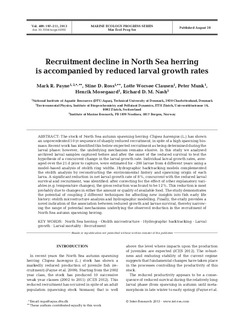| dc.contributor.author | Payne, Mark R. | |
| dc.contributor.author | Ross, Stine D. | |
| dc.contributor.author | Clausen, Lotte Worsøe | |
| dc.contributor.author | Munk, Peter | |
| dc.contributor.author | Mosegaard, Henrik | |
| dc.contributor.author | Nash, Richard D.M. | |
| dc.date.accessioned | 2013-10-23T12:10:29Z | |
| dc.date.issued | 2013-08-28 | |
| dc.identifier.citation | Payne MR, Stine DR, Worsøe Clausen L, Munk P, Mosegaard H, Nash RDM (2013) Recruitment decline in North Sea herring is accompanied by reduced larval growth rates. Mar Ecol Prog Ser 489:197-211 | no_NO |
| dc.identifier.issn | 0171-8630 | |
| dc.identifier.issn | 1616-1599 | |
| dc.identifier.uri | http://hdl.handle.net/11250/109219 | |
| dc.description.abstract | The stock of North Sea autumn spawning herring Clupea harengus (L.) has shown an unprecedented 10 yr sequence of sharply reduced recruitment, in spite of a high spawning biomass. Recent work has identified this below-expected recruitment as being determined during the larval phase: however, the underlying mechanism remains elusive. In this study we analysed archived larval samples captured before and after the onset of the reduced survival to test the hypothesis of a concurrent change in the larval growth rate. Individual larval growth rates, averaged over the 21 d prior to capture, were estimated for ~200 larvae from 4 different years using a model-based analysis of otolith ring widths. Hydrographic backtracking models complemented the otolith analysis by reconstructing the environmental history and spawning origin of each larva. A significant reduction in net larval growth rate of 8%, concurrent with the reduced larval survival and recruitment, was identified: after correcting for the effect of other explanatory variables (e.g. temperature changes), the gross reduction was found to be 12%. This reduction is most probably due to changes in either the amount or quality of available food. The study demonstrates the potential of coupling 2 different techniques for affording new insights into fish early life history: otolith microstructure analysis and hydrographic modelling. Finally, the study provides a novel indication of the association between reduced growth and larvae survival, thereby narrowing the range of potential mechanisms underlying the observed reduction in the recruitment of North Sea autumn spawning herring. | no_NO |
| dc.language.iso | eng | no_NO |
| dc.publisher | Inter-Research | no_NO |
| dc.subject | herring | no_NO |
| dc.subject | sild | no_NO |
| dc.subject | fish larvae | no_NO |
| dc.subject | fiskelarver | no_NO |
| dc.subject | growth | no_NO |
| dc.subject | vekst | no_NO |
| dc.subject | mortality | no_NO |
| dc.subject | dødelighet | no_NO |
| dc.title | Recruitment decline in North Sea herring is accompanied by reduced larval growth rates | no_NO |
| dc.type | Journal article | no_NO |
| dc.type | Peer reviewed | no_NO |
| dc.subject.nsi | VDP::Agriculture and fishery disciplines: 900::Fisheries science: 920::Fish health: 923 | no_NO |
| dc.subject.nsi | VDP::Agriculture and fishery disciplines: 900::Fisheries science: 920::Aquaculture: 922 | no_NO |
| dc.description.embargo | 2018-08-28 | |
| dc.source.pagenumber | 197-211 | no_NO |
| dc.source.volume | 489 | no_NO |
| dc.source.journal | Marine Ecology Progress Series | no_NO |
| dc.identifier.doi | 10.3354/meps10392 | |
